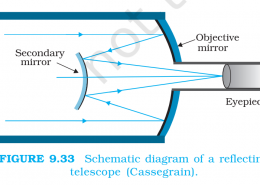Class 12 Physics
CBSE and UP Board
Ray Optics and Optical Instruments
Chapter-9 Exercise 9.36
NCERT Solutions for Class 12 Physics Chapter 9 Question-36
A Cassegrain telescope uses two mirrors as shown in Figure.9.33 Such a telescope is built with the mirrors 20 mm apart. If the radius of curvature of the large mirror is 220 mm and the small mirror is 140 mm, where will the final image of an object at infinity be?
Share

The following figure shows a Cassegrain telescope consisting of a concave mirror and a convex mirror.
Distance between the objective mirror and the secondary mirror, d = 20 mm
Radius of curvature of the objective mirror, R1= 220 mm
Hence, focal length of the objective mirror, f1= R1/R2 = 110 mm
Radius of curvature of the secondary mirror, R2 = 140 mm
Hence, focal length of the secondary mirror, f2 =R2 /2= 70 mm
The image of an object placed at infinity, formed by the objective mirror, will act as a virtual object for the secondary mirror.
Hence, the virtual object distance for the secondary mirror, u = f1-d = 110 -20 =90mm
Applying the mirror formula for the secondary mirror, we can calculate image distance (v) as:
1/v + 1/u = 1/f2
1/v = 1/f2– 1/u
= 1/70 -1/90 = (9-7)/630 = 2/630
Therefore ,V = 630/2 = 315 mm
Hence, the final image will be formed 315 mm away from the secondary mirror.